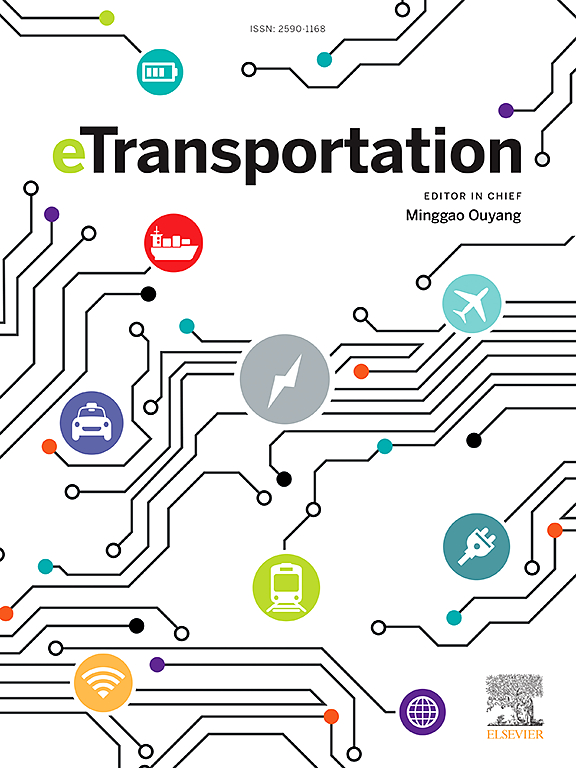Will it get there? A deep learning model for predicting next-trip state of charge in Urban Green Freight Delivery with electric vehicles
IF 15
1区 工程技术
Q1 ENERGY & FUELS
引用次数: 0
Abstract
To enhance urban freight efficiency and green development, China has implemented the Urban Green Freight Delivery (UGFD) project, which includes optimizing vehicle traffic control policies and increasing the number of new energy vehicles (NEV). However, range anxiety is a significant challenge for freight drivers performing delivery tasks with electric vehicles (a major component of NEV). We constructed a prediction model for the state of charge (SOC), or battery remaining energy percentage when UGFD vehicles reach the next trip point, aiming to alleviate this issue. The model consists of three modules: (1) a vehicle SOC context prediction module, (2) a vehicle energy consumption prediction module, and (3) a multi-perspective SOC prediction value fusion module. Specifically, in the SOC context prediction module, historical SOC sequences, vehicle status (loading/unloading, charging), and time intervals between SOC points are used to accurately describe context change trends, and directly predict the vehicle SOC at the next trip point. The energy consumption prediction module combines community-level and grid-level geographical location information for the vehicle stops using weather, vehicle parameters, etc., to model the spatial dynamic correlation of energy consumption. The vehicle SOC at the next trip point is the difference between the current vehicle SOC and the predicted energy consumption. The multi-perspective SOC prediction value fusion module is a combination of the predicted values from the context and energy consumption perspectives, resulting in the final vehicle SOC prediction value. Taking Suzhou, China as an example, the results show that the mean absolute error, root mean square error, and symmetric mean absolute percentage error for the constructed model are 23.67%, 10.39%, and 20.03% less, respectively, than for the baseline models focusing on SOC short-term time series prediction. The research results can provide scientific evidence for formulating refined energy management, charging station layout, and freight delivery optimization approaches.
它能到达目的地吗?用于预测城市绿色货运中电动汽车下一趟充电状态的深度学习模型
为提高城市货运效率,促进绿色发展,中国实施了城市绿色货运(UGFD)项目,其中包括优化车辆交通管制政策和增加新能源汽车(NEV)数量。然而,对于使用电动汽车(新能源汽车的主要组成部分)执行配送任务的货运司机来说,续航焦虑是一个重大挑战。我们构建了一个预测模型,用于预测 UGFD 车辆到达下一个行程点时的充电状态(SOC)或电池剩余能量百分比,旨在缓解这一问题。该模型由三个模块组成:(1) 车辆 SOC 情境预测模块;(2) 车辆能耗预测模块;(3) 多视角 SOC 预测值融合模块。具体来说,在 SOC 情境预测模块中,历史 SOC 序列、车辆状态(装载/卸载、充电)和 SOC 点之间的时间间隔被用来准确描述情境变化趋势,并直接预测下一个行程点的车辆 SOC。能耗预测模块结合社区级和网格级的车辆停靠地理位置信息,利用天气、车辆参数等建立能耗空间动态关联模型。下一个行程点的车辆 SOC 是当前车辆 SOC 与预测能耗之间的差值。多视角 SOC 预测值融合模块是将情境和能耗视角的预测值进行组合,得出最终的车辆 SOC 预测值。以中国苏州为例,研究结果表明,所构建模型的平均绝对误差、均方根误差和对称平均绝对百分比误差分别比以 SOC 短期时间序列预测为主的基线模型小 23.67%、10.39% 和 20.03%。研究成果可为制定精细化能源管理、充电站布局和货运优化方法提供科学依据。
本文章由计算机程序翻译,如有差异,请以英文原文为准。
求助全文
约1分钟内获得全文
求助全文
来源期刊

Etransportation
Engineering-Automotive Engineering
CiteScore
19.80
自引率
12.60%
发文量
57
审稿时长
39 days
期刊介绍:
eTransportation is a scholarly journal that aims to advance knowledge in the field of electric transportation. It focuses on all modes of transportation that utilize electricity as their primary source of energy, including electric vehicles, trains, ships, and aircraft. The journal covers all stages of research, development, and testing of new technologies, systems, and devices related to electrical transportation.
The journal welcomes the use of simulation and analysis tools at the system, transport, or device level. Its primary emphasis is on the study of the electrical and electronic aspects of transportation systems. However, it also considers research on mechanical parts or subsystems of vehicles if there is a clear interaction with electrical or electronic equipment.
Please note that this journal excludes other aspects such as sociological, political, regulatory, or environmental factors from its scope.
 求助内容:
求助内容: 应助结果提醒方式:
应助结果提醒方式:


